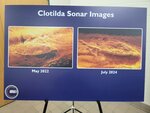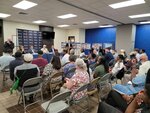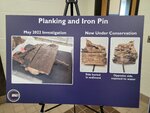Imagine being torn from your home, crammed into a ship's hold with 109 others, some as young as 2 years old, forced to endure a 45-day journey in a space so small that you're either lying on your …
This item is available in full to subscribers.
Please log in to continue |




Imagine being torn from your home, crammed into a ship's hold with 109 others, some as young as 2 years old, forced to endure a 45-day journey in a space so small that you're either lying on your side or stacked on top of one another. There are no facilities, and food is only provided when your captors feel inclined.
This grim reality is just a fraction of the suffering endured by those aboard the Clotilda, the last known slave ship to arrive in the United States.
"It is Hell on Earth, because we do that as people, don't we?" said James Delgado of Search Inc., addressing attendees at the Alabama Historical Commission's meeting on the evening of Aug. 8. The meeting marked the conclusion of phase three of the Clotilda research, an investigation that has brought the ship's harrowing story to light and set the stage for its preservation.
The meeting focused on presenting scientific findings about the current state of the Clotilda to the community. Panelists from the Alabama Historical Commission, Resolve Marine Group, U.S. Army Corps of Engineers and Search Inc. answered questions and laid out a possible future for the Clotilda.
"This phase of the investigation was vital in determining the next steps for the Clotilda," Alabama Historical Commission Chairman Eddie Griffith said. "With this report, the Alabama Historical Commission can continue with its preservation plan and continue preserving this tremendous artifact and its history."
The Clotilda, discovered in 2019 after its existence was denied for years, illegally transported 110 people from Benin, Africa, to Mobile in 1860, over 50 years after the United States banned the international slave trade. The ship was deliberately sunk by co-conspirators Timothy Meaher and Capt. William Foster to destroy evidence of their crime. The wreckage lay hidden for over a century until its discovery brought to light a painful chapter in American history.
This part of the investigation of the wreckage included a range of studies designed to assess the ship's condition and the risks it faces. These studies involved a high-resolution sonar survey to capture detailed imagery of the vessel, a marine geological study to analyze the sediment around the wreck, and an engineering assessment to evaluate the site's stability. The investigation also included a biological assessment to determine the impact of marine life on the wreck and a limited excavation to further examine the ship's remains.
The findings of this investigation were sobering. The Clotilda's structural integrity has been severely compromised by over 160 years of natural and human-induced damage. The metal fasteners holding the wreck together have corroded significantly, and the wood has suffered extensive cracking and splitting. The ship has also been subjected to physical damage from floating objects, vandalism, looting and severe weather. The shallow, brackish water in which the Clotilda rests has caused ongoing erosion, biological deterioration and further weakening of the ship's structure.
Despite these challenges, the Clotilda retains archaeological integrity, meaning it still has the potential to tell its story through careful scientific study.
However, raising the ship intact is not feasible with current technology due to its compromised condition. As a result, the AHC has determined that in situ preservation is the most scientifically responsible and least damaging approach. This method involves covering exposed elements of the wreck with sediment to create a near-zero oxygen environment, which will help protect the Clotilda from further decay.
"Archaeological integrity and structural integrity are two different concepts," State Archaeologist Stacye Hathorn said. "Archaeological integrity means that the vessel still has the ability to tell its story through careful scientific investigation. Structural integrity means that the structure of the vessel remains strong and intact. This study has demonstrated that while the Clotilda retains significant archaeological integrity, its structural integrity has been severely compromised by the original act of barratry and subsequent impacts, both natural and human, over the past 164 years."
After the Civil War, a small group of the ship's survivors and their descendants established Africatown, a community in Mobile that remains a symbol of resilience and cultural heritage.
The Clotilda's story has also been brought to life in literature. In January, Hannah Durkin published "The Survivors of the Clotilda: The Lost Stories of the Last Captives of the American Slave Trade." The 432-page book offers a deeply researched account of the lives of the Clotilda's 110 captives, from their abduction in Africa to their enslavement in Alabama, and their legacy in the Civil Rights movement and beyond. The book has been praised for its detailed portrayal of the Black experience and its contribution to understanding America's tragic past.
With the report released and data available, it is now up to the descendants of the Clotilda and the Africatown community to decide the best course of action for this historic landmark.
"You now, as a community, have through this report with engineers and others looking at it, you now can begin to access a series of options working with the state," Search Inc.'s Delgado said. "These range from the question of raising some or all of it to leaving it in place and memorializing it. They range from further work, they also range in terms of what more you would also want to do in regard to if it were to stay in place, how best to share that story whether it's artifacts from the vessel, partial recreation of the vessel in an expanded heritage house or museum or things of that sort."
Local journalist and filmmaker Ben Raines discovered the Clotilda and has been striving to raise it so the story can be told much more effectively as people will be able to see the vessel. Delgado said it would cost tens of millions of dollars as well time to raise the Clotilda if that is what is chosen. He also said building a partial replica could take a year, while a full replica could be completed within five. According to the AHC, $3.5 million has gone toward the Clotilda investigation, but with the data from the phase three study, the organization will work toward doing what it can to secure more funds to protect the Clotilda site as well memorialize the it in whatever way is decided.